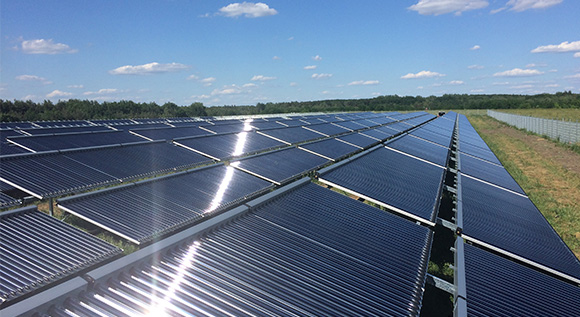The sunny side of the energy transition
Germany is a global leader in technology for the energy transition. In order to make the energy transition a success, transitioning to renewable heat generation is key. Here, solar thermal energy plays a crucial role and Germany has been conducting cutting-edge research in this area for more than 25 years.
 © RXLS/Alexander Jandrey
© RXLS/Alexander Jandrey
Solar thermal installations have been used since the 1970s, mostly for heating water, and latterly also for heating homes. It was also in the mid-1970s that the first solar homes were built. The first home able to generate as much energy as it consumed – a sensation at the time – was completed in Freiburg in 1992.
The first research funding programmes launched to promote solar thermal energy included ‘Solar thermal energy 2000’ (from 1994 to 2003) and "Solar thermal 2000 plus" (from 2004 to 2008). Today, these programmes are being continued under the Federal Government’s 7th Energy Research Programme entitled "Innovation for the Energy Transition". The two initial programmes helped create and test the technology needed for developing large solar thermal installations and long-term heat storage. The findings of this research served as the basis for developing both the technology and the market.
A pioneer in international solar thermal energy research
Right from the beginning, Germany played a key role in international solar thermal energy research. The International Energy Agency for example established a number of research cooperation projects that placed a strong focus on technology. One of these is the Solar Heating and Cooling Programme (SHC), which was launched in 1977. Today, experts from 20 countries are using this project to work together on a wide range of subjects – from photovoltaic-thermal collectors and process heat all the way to solar heat networks.
The European standard for solar thermal installations – which was published in 2000 – was drafted with considerable help from German experts on solar energy. The European certification mark for solar thermal products – the Solar Keymark – which was developed as part of this process can be found today on around 1,500 different products on the European market; persons buying solar collectors are only eligible for funding under the Market Incentive Programme (MAP) if they buy a product bearing this certification mark. A unified and global certification is currently being worked on, once again with the help of German experts.
The energy transition: impossible without solar thermal energy
Dr Frank Heidrich, who heads the Directorate on Heat and Efficiency in Buildings at the Federal Ministry for Economic Affairs and Energy, is convinced that the energy transition cannot succeed without the contribution of solar thermal energy. This May, he joined with experts on solar thermal energy to discuss key issues of solar thermal research at a German conference on solar thermal energy and innovative heating systems. The participants of the conference agreed that research in the field of low temperature solar thermal energy – including storage and collector technology, systems technology and new fields of application – was at a high level all across Germany.
The solar thermal energy market has seen continuous growth since the beginning of the 1990s. However, it has been faced with strong competition from other solar technologies for some years. The Solar Heat Worldwide report – which was launched 15 years ago – provides an annual and detailed update on the development of the global market. At the end of 2018, around 686 million square metres (480 GW) of collector surface area was installed. Germany ranks fourth behind China, the US and Turkey in terms of installed collector surface area and installed solar thermal capacity. This means that more than 20 million square metres of solar collector surface was installed in Germany at the end of 2018, which corresponds to 14.4 GW of installed solar thermal capacity.
Germany – the global leader on solar thermal technology
Since the beginning of solar thermal research, Germany has been and continues to be the global leader in the development of solar thermal technology. Whilst this is not equally reflected by the current market growth rates, however, there are several studies that suggest that solar thermal energy has the potential to cover a fourth of the total demand for low-temperature heat.
Experts in solar thermal energy believe that solar thermal energy could be used particularly in the areas of solar process heat, heat networks and solar building design – from building passive houses all the way to passive districts and solutions that integrate solar thermal energy into a building’s facade. In this context, dovetailing the electricity and heat markets will play a crucial role – for example in order to convert surplus electricity from renewable sources to thermal energy so it can be stored. As part of the Heat Network 4.0 pilot project, research funding and market incentives are being combined.
The funds earmarked for research funding for solar thermal energy have continuously increased over the last 25 years. In addition, the Market Incentive Programme (MAP) was used to provide around 1.46 billion in investment grants for around 1.2 million solar installations between 2000 and 2017.

